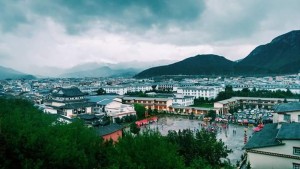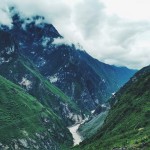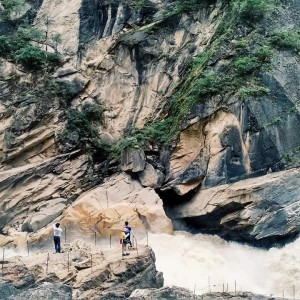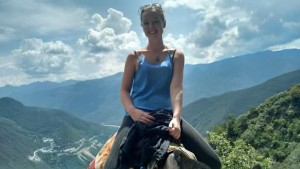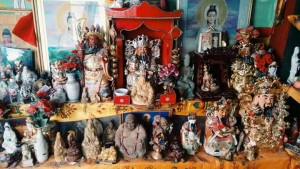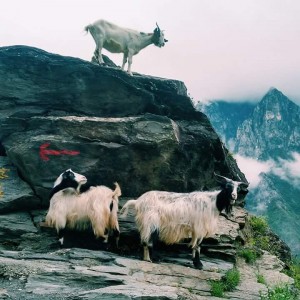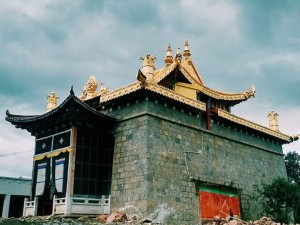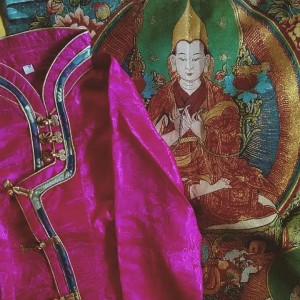丽江-虎跳峡-香格里拉
你可能要问问,能走到天边吗?
我说的天边是中国的边缘,那就是香格里拉。香格里拉实质上就是指云南的迪庆藏族自治州。 想到那个偏僻的地域,火车也不螚坐。爬小山丘上白鸡寺去,一望无际的草原呈现在眼前,给香格里拉一种西部风情的感觉,像美国西部沙漠中的孤立小镇似的。
小牛仔,老沙龙酒吧呢?想也别想。这里看不到牛仔裤,只能看到少数民族鲜艳的服装。这里买不到美国啤酒,只要喝藏族的青稞酒。
“不必到西藏就可领略藏族风情”。迪庆不仅有西藏高原雪山峡谷的风貌和藏族风情,还可领略到内蒙古大草原“风吹草低见牛羊”般的壮丽景色,让我想起“回到拉萨”那首郑钧的歌曲,“在雪山之颠把我的魂唤醒”。
怎么来到这么偏僻的地方呢?走进香格里拉我们决定先去虎跳峡。虎跳峡以‘险’闻名天下,这里不仅山险,水更险,但对我来说,更险的地方更具挑战性,才让我向前。
我们沿山路前行,一尺宽的小经,脚下是深不见底的悬崖,偶尔不小心碰落一颗小石头要很久才能见到它落进江心激起浪花。我们小心翼翼地靠近岩石,慎重前进。一路上,大家不说一句话,只有手劲和眼神在互相传递着内心的思想。终于,我们到达了虎跳峡的最高点,28拐的高点,这才发现冷汗早已浸透了所有的衣服。
抬头看看位于对面的玉龙雪山,只见山顶上白雪皑皑,给山峰披上银色的外衣,分不清哪里是山,哪里是天。低头往下看看滚滚而去的江水,感觉虎跳峡太壮丽了,在高耸的雪山面前,才发现自己的确太渺小了。
在路认识了许多马夫,他们没两天都会爬28拐一次,年龄最大的连有50岁以上的,但比我爷爷身体强得多。虽然工作艰难,生活条件简单,但是都有很阳光的态度。他们的世界范围那么小,以山上的小村庄为中心,也不了解虎跳峡之外的生活如何。我觉得这样简朴的人可能比大城市的还幸福。
香格里拉给我留了印象最深的地方是其佛教文化。 除了那个白鸡寺我们一家还参观了其他几个小寺庙。虽然年久失修,但是有一种迷人的魅力。范围小,游客不多,很正宗的。回来了北京去参观雍和宫的时候,光鲜的外在有点空空的,没有香格里拉的喇嘛庙好看。有一小场景特别难忘,那就是在白鸡寺展示的小佛像,估计有一百多个小佛像摆在门口,表情都很神奇,在那个安安静静的屋里真让我感动。
为了让我记得梦幻般的香格里拉,我买了几个纪念品,其中有衣服、珠宝饰物还有一张挂毯。
我在此想表现我对John Speak的万分感激,让我过去12个月能享受这么多新鲜的东西,让我能旅游到这么多地方,没有这个奖学金我这一次来中国交换真的会缺很多。
ENGLISH TRANSLATION:
Lijiang-Tiger Leaping Gorge-Shangrila
You might be wondering, can one really travel to the very end of this earth?
The end of the earth I am talking about it the outer border of China, the middle kingdom. Shangrila, to be precise. Technically it should be referred to Zitai prefecture in Diqing Tibetan county of Yunnan. If you wish to reach that remote place, not even a train can take you there. From the Baiji temple atop a small hill overlooking the city, you can see grassy planes as far as the eye can see. Shangrila has almost the feeling of a town in the American Wild West, lonely in the midst of a desolate desert landscape.
But try and find some jeans or a saloon bar in that place? No chance. The locals only wear traditional clothing, and instead of beer you’re more likely to come across barley wine.
There is a saying which goes, ‘you need not go all the way to Tibet to experience its culture’. In Diqing, there is not only an abundance of snowy peaks and steep valleys in true Tibetan style, but also magnificent grassy planes reminiscent of Mongolia’s vast nomadic landscape. It reminded me of the song “Returning to Lahasa” (the capital of Tibet) by the singer Zheng Jun, in which there is a line “the peak of the snow mountain brings my spirit to its senses”.
How did we reach such a remote location in the first place? Upon arrival in Shangrila country we decided to head for Tiger Leaping Gorge, a place renowned for its rugged hazardous terrain, with precipitous cliff faces and a roaring torrent rushing through the length of the valley. However, the danger factor makes it more of an adventure and definitely pushes you further.
We followed the tiny mountain path, seemingly only inches wide. Below us was the unfathomable precipice, and every so often someone would accidentally knock a small stone which would fall down, down down. Only minutes later would you see it splash into the frothing current. Cautiously we made our way, keeping close to the cliff edge.
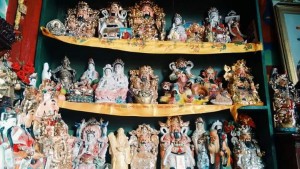 No one dared say a word, concentrating only on our hand movements and keeping a close watch on our steps. Finally, we reached the highest point, the top of the 28 bends. It was only then we realised we were completely drenched in sweat.
No one dared say a word, concentrating only on our hand movements and keeping a close watch on our steps. Finally, we reached the highest point, the top of the 28 bends. It was only then we realised we were completely drenched in sweat.
Looking up, you could see the Jade Dragon Snow Mountain on the other side of the valley, but all that was really clear was the crisp snow caps on its peak, a kind of silvery blanket. I couldn’t tell the where the sky ended and the mountain began . Looking down was the surging stream. Tiger Leaping Gorge was so breathtaking, and with the towering mountain in front of us I realised the extent of my own insignificance.
On the way up we met a lot of horse-keepers. They said they did the climb once every two days, even though some of them were over 50 years old. However, I think they were a lot stronger than my own grandfather! Although they lived a tough life, they had a very positive outlook. Their universe was in some respects limited, revolving around their mountainside village, not quite aware of what lay beyond. On the other hand, I feel like they were much more content with their lot than a lot of people who live in the big cities.
What left me with the strongest impression in Shangrila was the Buddhist culture I saw there. Apart from the Baiji Temple I mention, there were also a lot of other little monasteries we looked around. Although some of them had fallen into disrepair, they had a kind of charm to them. They were small, without too many visitors, and very authentic. When I went to Lama Temple after returning to Beijing, its polished exterior felt empty somehow, and definitely didn’t live up to those little places in Shangrila. There was one scene which stayed with me in particular, a display of Buddha statues arranged at the entrance to Baiji temple. There must have been over a hundred wise smiling faces, which gave the peaceful temple a very mysterious and holy feel.
Before leaving, I brought a few souvenirs to remember the place by, including some clothes, jewelry and a wall hanging.
I would like to take this opportunity to sincerely thank the John Speak Trust for everything they have given me this year, for giving me the chance over the last 12 months to see so many amazing things and travel to some incredible places I would have missed out on otherwise. My year abroad really would have been a different tale had it not been for their wonderful help.

